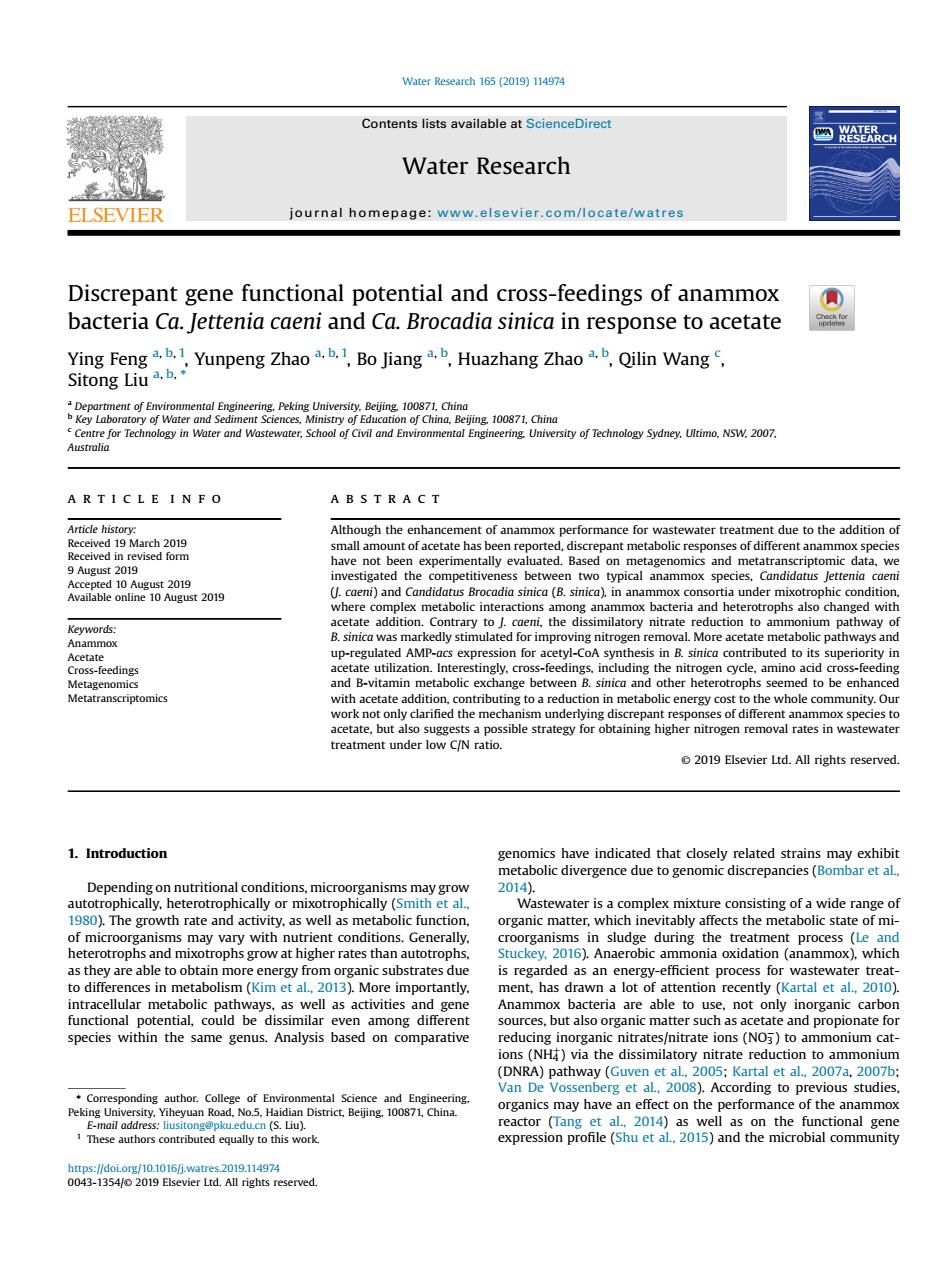正在加载图片...

Water Research 16 (1)114974 Contents lists available at ScienceDirect Water Research ELSEVIER journal homepage:www.elsevier.com/locate/watres Discrepant gene functional potential and cross-feedings of anammox bacteria Ca.Jettenia caeni and Ca.Brocadia sinica in response to acetate Ying Feng,Yunpeng Zhao.Bo Jiang,Huazhang Zhao Qilin Wang, Sitong Liu. School of Civil and Em ARTICLE INFO ABSTRACT ugh the enhancement of anam mox ater treatment due to the additic not be tally Based on and metabolic int aa nhs also d amino a worknotonycdharifetnmt hanism ethingdise treatment under owCN ratio. 1.Introduction trop sm9 microoganlisnms may vary with n rient cond tions.Generally organisms ludge during ment process as they are able too in mo nergy fro reg rded as an er trea 2 ergy-efficient pre etab olic as well as activities and teria are abl to use.not o ly inorganic carb d a th berg eta)According to prevo studie ctor (Tan 01 as on the onal gene qually to this Discrepant gene functional potential and cross-feedings of anammox bacteria Ca. Jettenia caeni and Ca. Brocadia sinica in response to acetate Ying Feng a, b, 1 , Yunpeng Zhao a, b, 1 , Bo Jiang a, b , Huazhang Zhao a, b , Qilin Wang c , Sitong Liu a, b, * a Department of Environmental Engineering, Peking University, Beijing, 100871, China b Key Laboratory of Water and Sediment Sciences, Ministry of Education of China, Beijing, 100871, China c Centre for Technology in Water and Wastewater, School of Civil and Environmental Engineering, University of Technology Sydney, Ultimo, NSW, 2007, Australia article info Article history: Received 19 March 2019 Received in revised form 9 August 2019 Accepted 10 August 2019 Available online 10 August 2019 Keywords: Anammox Acetate Cross-feedings Metagenomics Metatranscriptomics abstract Although the enhancement of anammox performance for wastewater treatment due to the addition of small amount of acetate has been reported, discrepant metabolic responses of different anammox species have not been experimentally evaluated. Based on metagenomics and metatranscriptomic data, we investigated the competitiveness between two typical anammox species, Candidatus Jettenia caeni (J. caeni) and Candidatus Brocadia sinica (B. sinica), in anammox consortia under mixotrophic condition, where complex metabolic interactions among anammox bacteria and heterotrophs also changed with acetate addition. Contrary to J. caeni, the dissimilatory nitrate reduction to ammonium pathway of B. sinica was markedly stimulated for improving nitrogen removal. More acetate metabolic pathways and up-regulated AMP-acs expression for acetyl-CoA synthesis in B. sinica contributed to its superiority in acetate utilization. Interestingly, cross-feedings, including the nitrogen cycle, amino acid cross-feeding and B-vitamin metabolic exchange between B. sinica and other heterotrophs seemed to be enhanced with acetate addition, contributing to a reduction in metabolic energy cost to the whole community. Our work not only clarified the mechanism underlying discrepant responses of different anammox species to acetate, but also suggests a possible strategy for obtaining higher nitrogen removal rates in wastewater treatment under low C/N ratio. © 2019 Elsevier Ltd. All rights reserved. 1. Introduction Depending on nutritional conditions, microorganisms may grow autotrophically, heterotrophically or mixotrophically (Smith et al., 1980). The growth rate and activity, as well as metabolic function, of microorganisms may vary with nutrient conditions. Generally, heterotrophs and mixotrophs grow at higher rates than autotrophs, as they are able to obtain more energy from organic substrates due to differences in metabolism (Kim et al., 2013). More importantly, intracellular metabolic pathways, as well as activities and gene functional potential, could be dissimilar even among different species within the same genus. Analysis based on comparative genomics have indicated that closely related strains may exhibit metabolic divergence due to genomic discrepancies (Bombar et al., 2014). Wastewater is a complex mixture consisting of a wide range of organic matter, which inevitably affects the metabolic state of microorganisms in sludge during the treatment process (Le and Stuckey, 2016). Anaerobic ammonia oxidation (anammox), which is regarded as an energy-efficient process for wastewater treatment, has drawn a lot of attention recently (Kartal et al., 2010). Anammox bacteria are able to use, not only inorganic carbon sources, but also organic matter such as acetate and propionate for reducing inorganic nitrates/nitrate ions (NO3 ) to ammonium cations (NH4 þ) via the dissimilatory nitrate reduction to ammonium (DNRA) pathway (Guven et al., 2005; Kartal et al., 2007a, 2007b; Van De Vossenberg et al., 2008). According to previous studies, organics may have an effect on the performance of the anammox reactor (Tang et al., 2014) as well as on the functional gene expression profile (Shu et al., 2015) and the microbial community * Corresponding author. College of Environmental Science and Engineering, Peking University, Yiheyuan Road, No.5, Haidian District, Beijing, 100871, China. E-mail address: liusitong@pku.edu.cn (S. Liu). 1 These authors contributed equally to this work. Contents lists available at ScienceDirect Water Research journal homepage: www.elsevier.com/locate/watres https://doi.org/10.1016/j.watres.2019.114974 0043-1354/© 2019 Elsevier Ltd. All rights reserved. Water Research 165 (2019) 114974